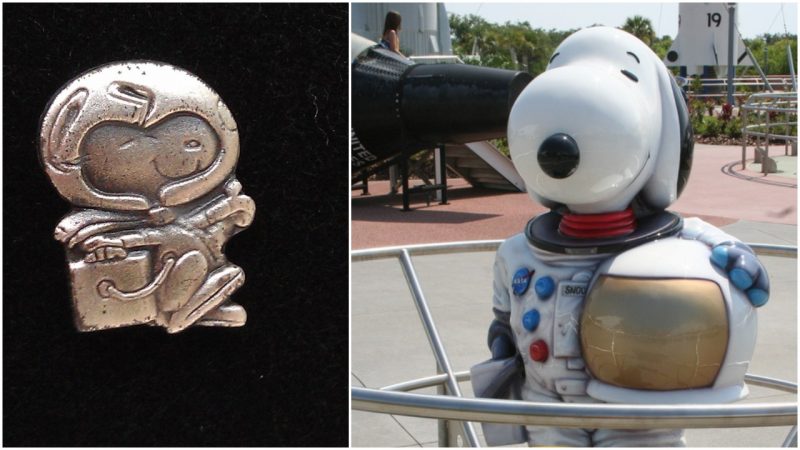
It is perhaps the most coveted Space Flight Awareness award, and it’s hard to win. Less than 1 percent of the aerospace program workforce receives it annually, according to NASA, and the criteria of significant contributions is long.
What is this prestigious award? A Snoopy lapel pin.
Yes, that Snoopy, from the long-running Charles M. Schulz comic strip Peanuts. Specifically, a sterling silver Snoopy pin, the beagle wearing a fishbowl space helmet, with his ears arced in joy and an oxygen tank nestled by his dancing feet.
The Silver Snoopy award is presented personally by an astronaut. It is not given to supervisors but is reserved for employees who have gone above and beyond in increasing quality, reliability, safety, operational improvements, and efficiency along with cost savings “to ensure flight safety and mission success,” according to NASA.gov. An awardee can receive only one during his or her lifetime. The Snoopy pin is one that has actually traveled in space—a certificate tells recipients on which mission the silver pup flew.
The marriage of a cartoon beagle and an ascendant space program is emblematic of the hopeful, earnest 1960s. Schulz’s comic strip, which he began publishing in the 1950s, was at its peak. Peanuts ran in 2,600 newspapers, was translated into 21 languages, spawned several still-running Emmy-award-winning classic TV specials, a Broadway musical, and along with merchandising, made the creator a billionaire by the time of his death in 2000.

NASA Silver Snoopy award lapel pin (tie tack) flown aboard STS-116 Photo:Nitrorat CC BY-SA 3.0
Peanuts centered around Charlie Brown and his circle of friends, Lucy, Linus, and Peppermint Patty, and his little sister, Sally. But the most popular, endearing, and enduring character was Snoopy, whose many fantasies included one as a World War I Flying Ace piloting a Sopwith Camel (his red doghouse) in battles against the evil Red Baron.
It was Snoopy’s World War I Flying Ace that likely caught the imagination of NASA’s director of public affairs in the late 1960s.
In January 1967, NASA suffered a serious and catastrophic setback in the Space Race against the U.S.S.R. to land a man on the moon before the end of the decade, per John F. Kennedy’s 1961 challenge.
The crew of Apollo 1, which was to be the first manned Apollo flight, was going through a pre-launch testing at the Kennedy Spaceflight Center, in Cape Canaveral, Florida. Commander Gus Grissom and Senior Pilot Ed White, along with a rookie, pilot Roger Chaffee, went through five and a half hours of checking with only minor problems, among them; however, they had a spotty communication system. Shortly after 6:30 on the night of January 27, the crew yelled garbled messages of “Fire” and “Let’s get out!”

Snoopy statue at the Kennedy Space Center rocket garden.Photo: RadioFan CC BY-SA 3.0
The crew couldn’t escape. Engineers couldn’t pry open the hatch, and within 3 seconds, the pressurized capsule blew up, killing the men within a minute and destroying the module.
The fire was devastating. It shattered the morale of NASA’s employees and the public’s perception of space safety.
As NASA’s team of engineers worked feverishly to discover and correct what had gone wrong, its public affairs department had to assure people of the program’s ultimate safety and security. That’s when the director approached Charles Schulz for permission to use Snoopy as a mascot. It seemed like a natural fit for the canine “World War I Flying Ace” to fly to the moon as the “World Famous Astronaut.”
Though Schulz was legendarily careful about the use of his cartoon characters—some might have described him as difficult—he was a big fan of space travel. Some friends warned him against the idea, saying it was risky. What if another mission blew up, this time with Snoopy on it? But Schulz was thrilled.

Ralph Brown receives the Silver Snoopy Award from Astronaut Danny Olivas.
“It went down in his life as one of the all-time highlights of his career,” his son Craig Schulz told SPACE.com in 2010. “His comment was that if the astronauts could risk their lives, he could risk his characters.”
Schulz went right to work drawing up a template for what would become the Silver Snoopy lapel pin. By 1968, a Silver Snoopy went along on every astronaut’s ride into space. Shortly thereafter, the Silver Snoopy pins became a tradition and an honor.
On March 13, 1969, Schulz penned a strip with Snoopy in his bubble helmet atop his doghouse thinking, “Here’s the world-famous astronaut approaching the Moon.” In a later strip, Snoopy would do his characteristic leg-churning dance, celebrating himself as “the first beagle on the Moon!”
In May 1969, Apollo 10 traveled to the Moon on one last scouting mission before Apollo 11’s successful and historic lunar landing. The Apollo 10 cited Snoopy as their official mascot, tapping a nose of a stuffed beagle before launch and calling their lunar module Snoopy and the command module Charlie Brown. Back at ground control, a helmeted Snoopy figurine alongside a Charlie Brown sat atop the desk of Charlie Duke in the Mission Operations Control Room of Apollo 10.

